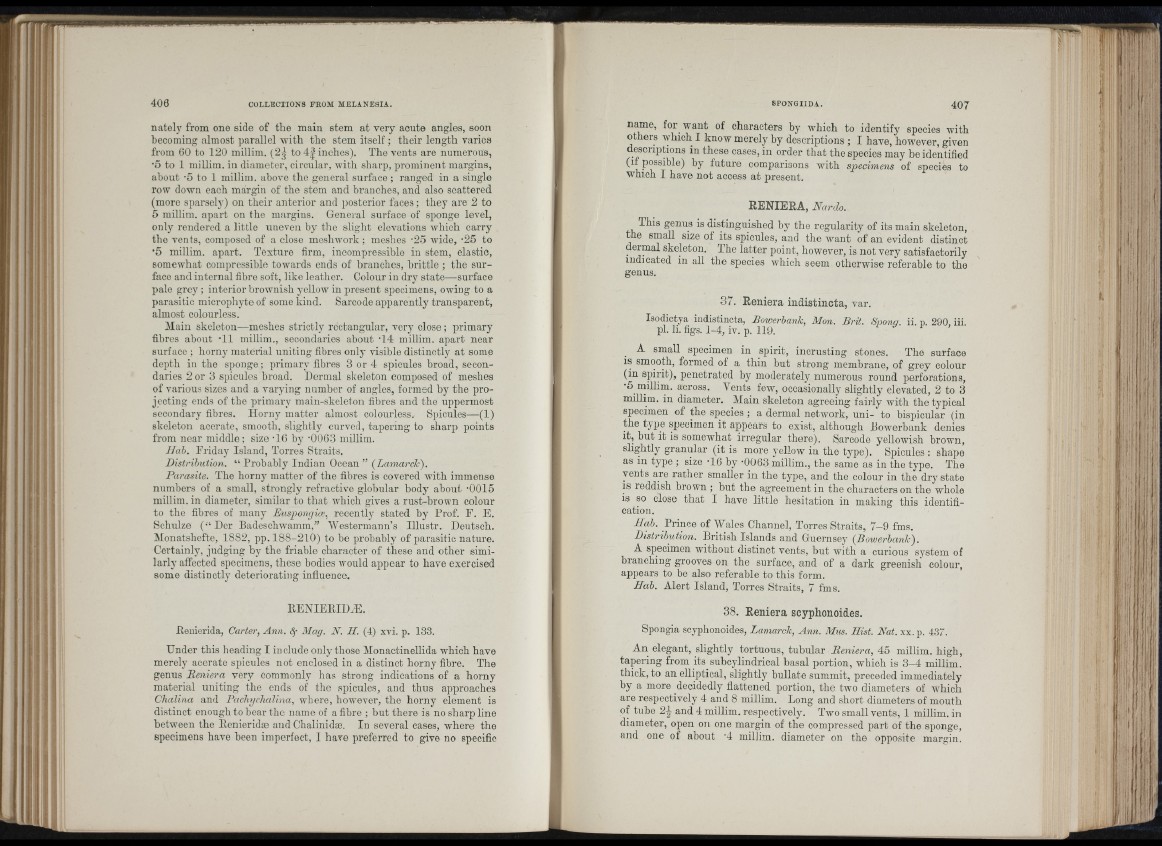
II
! Ü
! ■
I i
i 'i: i!
406 c o l l e c t io n s FEOM MELANESIA.
nately from one side of the main stem at very acute angles, soon
becoming almost parallel with tho stem itself ; their length varies
from 60 to 120 millim. (2 j to 4 | inches). The vents are numerous,
•5 to 1 millim. in diameter, circular, with sharp, prominent margins,
about -5 to 1 millim. above the general surface ; ranged in a single
row down each margin of the stem and branches, and also scattered
(more sparsely) on their anterior and posterior faces ; they are 2 to
5 millim. apart on the margins. General surface of sponge level,
only rendered a little uneven by the slight elevations which carry
tho vents, composed of a close meshwork ; meshes -25 wide, -25 to
•5 millim. apart. Texture firm, incompressible in stem, elastic,
somewhat compressible towards ends of branches, brittle ; the surface
and internal fibre soft, like leatlicr. Colour in dry state—surface
pale grey ; interior brownish yellow in present specimens, owing to a
parasitic microphyte of some kind. Sarcode apparently transparent,
almost colourless.
Main skeleton—meshes strictly rectangular, very close ; primary
fibres about -11 millim., secondaries about '14 millim. apart near
surface ; horny material uniting fibres only visible distinctly at some
depth in the sponge ; primary fibres 3 or 4 spicules broad, secondaries
2 or 3 spicules broad. Dermal skeleton composed of meshes
of various sizes and a varying number of angles, formed by the projecting
ends of the primary main-skeleton fibres and the uppermost
secondary fibres. Horuy matter almost colourless. Spicules—(1)
skeleton acerate, smooth, slightly curved, tapering to sharp points
from near middle; size -16 by -0063 millim.
Hab. Friday Island, Torres Straits.
Distribution. “ Probably Indian Ocean” (Lamardc).
Parasite. The horny matter of the fibres is covered with immense
numbers of a small, strongly refractive globular body about. -0015
millim. in diameter, similar to th at which gives a rust-brown colour
to the fibres of many Euspongice, recently stated by Prof. F. E.
Schulze (“ Der Badeschwamm,” Westermann’s Illustr. Deutsch.
Monatshefte, 1882, pp. 188-210) to be probably of parasitic nature.
Certainly, judging by the friable character of these and other similarly
affected specimens, these bodies would appear to have exercised
some distinctly deteriorating influence.
11ENIEPIDÆ.
Beiiierida, Carter, Ann. ^ Mag. N. II. (4) xvi. p. 133.
Under this heading I include only those Monactinellida which have
merely acerate spicules not enclosed in a distinct horny fibre. The
genus Reniera very commonly has strong indications of a horny
material uniting the ends of the spicules, aud thus approaches
Chalina and Padigdialina, where, however, the horny element is
distinct enough to bear the name of a fibre ; but there is no sharp line
between the Penieridæ and Chalinidæ. In several cases, where the
specimens have been imperfect, I have preferred to give no specific
SPONGIIDA . 407
name, for want of characters by which to identify species with
others which I know merely by descriptions ; I have, however, given
descriptions in these cases, in order th at the species may he identified
(if possible) by future com.parisons with spedmens of species to
which I have not access a t present.
EENIEEA, Nardo.
This genus is distinguished by the regularity of its main skeleton,
the small size of its spicules, and the want of an evident distinct
dermal skeleton. The latter point, however, is not very satisfactorily
indicated in all the species which seem otherwise referable to the
genus.
37. Reniera indistincta, var.
Isodictya indistincta, Rowerbank, Mon. Brit. Snonq ii. p. 290 iii
pi. li. figs. 1-4, iv. p. 119. Í y it ,
A small specimen in spirit, incrusting stones. The surface
is smooth, formed of a thin but strong membrane, of grey colour
(in spirit), penetrated by moderately numerous round perforations,
"5 millim. across. Vents few, occasionally slightly elevated, 2 to 3
miUim. in diameter. Main skeleton agreeing fairly with the typical
specimen of the species ; a dermal network, uni- to bispicular (in
the type specimen it appears to exist, although Bowerbank denies
it, but it is somewhat irregular there). Sarcode yellowish brown,
slightly granular (it is more yellow in the type). Spicules : shape
as in type ; size G6 by ’0063 millim., the same as in the type. The
yents are rather smaller in the type, and the colour in tho dry state
is reddish brown ; but the agreement in the characters on the whole
is so close th at I have little hesitation in making this identification.
Hah. Prince of Wales Channel, Torres Straits, 7 -9 fms.
Distribution. British Islands and Guernsey (Bowerhank).
A specimen without distinct vents, but with a curious system of
branching grooves on the surface, and of a dark greenish colour,
appears to be also referable to this form.
Hah. Alert Island, Torres Straits, 7 fms.
38. Reniera scypbonoides.
Spongia scypbonoides, Lamardc, Ann. Mus. Hist. Nat. xx. p. 437.
An elegant, slightly tortuous, tubular Reniera, 45 millim. high,
tapering from its subcylindrical basal portion, which is 3 -4 millim.
thick, to an elliptical, slightly búllate summit, preceded immediately
by a more decidedly flattened jiortion, the two diameters of which
are respectively 4 and 8 millim. Long and short diameters of mouth
of tube 24 and 4 millim. respectively. Two small vents, I millim. in
diameter, open on one margin of the compressed part of the sponge,
and one of about '4 millim. diameter on the opposite margin.
Mil ii:ih
I :
i \ 1 I '
Î ' ' Í.
!
; i
. I
,,